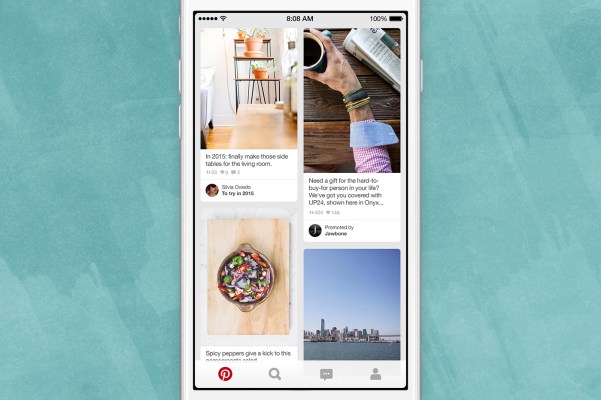More users will be seeing ads on Pinterest, the company announced on Tuesday, detailing an expanded test of its advertising product which will now place ads in the form of “Promoted Pins” directly in users’ home feeds. Because the home feed is the first thing you see when landing on Pinterest’s site, this will make the advertisements more visible to users of the social bookmarking service, which only last month said it was opening up access to “Promoted Pins” to all U.S.-based partners.
At that time, the company offered some insights around Promoted Pins performance, noting that the ads perform as well as, or, in some cases, better than organic Pins. Brand advertisers were seeing a 30 percent bump in earned impressions, said Pinterest, and the Pins continued to perform (seeing an extra 5 percent bump in earned media) after campaigns ended.
Pinterest has been slowly testing Promoted Pins on its service over the past year, having first debuted the Promoted Pin ad product with select brands in May 2014. Initially, these Pins were only available in search and in category feeds, which is where it made sense to first target users given that the service would be able to match ads with the category or search terms a consumer was interested in.
With the launch of ads on the Pinterest home feed, the bigger challenge now is to make sure the Pins shown are still relevant to users’ interests. To help it achieve a better understanding of this, the company has been building recommendation and personalization technologies, and acquiring companies that can aid it in more automated ways. For instance, the company acquired image recognition and visual search startup VisualGraph last year, and just this month, announced the acquisition of machine learning and recommendation engine Kosei.
With these technologies enhancing Pinterest’s own search, filtering and recommendation capabilities, the service can better personalize itself to end users – and can help brands better target the right users, too.
Now it’s time to see how well these systems are working – after all, with ads now appearing in the home feed, users may be more sensitive to those they feel don’t match their interests or those they just generally don’t like.
Pinterest says that it will allow users to hide individual ads, however, and offer feedback as to why in order to help the company improve its ads in the future. These Promoted Pins will also continue to be labeled as such, so it’s clear to users which Pins are ads versus not.
In addition, Pinterest is making sure home feed ads are of a high-caliber before being shown.
“An ad will be shown in a home feed if it meets certain performance metrics, ensuring that only high quality Promoted Pins will be shown in the home feed,” a company spokesperson explains. “An advertiser cannot specifically target the home feed only, they will target a category related to their Promoted Pins and we will show the ads to people we think may be interested in the category,” they note.
Because of this additional quality bar, there will be fewer home feed ads than those shown in search and category feeds.
Earlier reports in 2014 stated that Pinterest’s advertising was expensive at launch, with the company asking for $1 million and more for ad buys and CPMs between $30 and $40. But later, self-serve, performance-based offerings were aimed at bringing those costs down for other, smaller businesses.
The company declined to say how many advertisers it works with today, or how many are testing home feed ads. However, those that will be shown in the home feed include previous advertisers like Kraft, Target, General Mills and Ziploc, to name a few.
These ads will be priced at the same fixed CPM that’s charged for targeting the category feed, Pinterest tells us.
